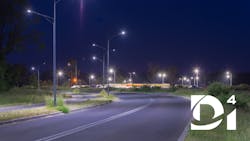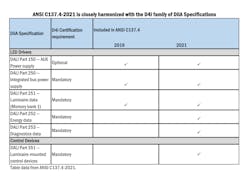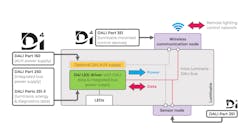The benefits of standards in lighting are well known: With global standards, lighting projects can be future-proofed, with no vendor lock-in, and customers benefit from long-term confidence in the supply chain. With compatible devices available from multiple sources, owners don’t need to throw away existing systems and start again when they want to make changes, saving money and reducing environmental impact.
However, lighting systems are getting smarter and more complex, employing a potentially overwhelming array of sensors, networked lighting controls (NLCs), and other devices. For any lighting control protocol, success depends on interoperability and backwards compatibility. The goal is to enable an ecosystem of products that comply with an evolving set of standards as connected lighting networks support new features and functions. In some cases, certification programs have been created to build confidence in the interoperability of components from different suppliers.
Standards for intelligent luminaires
Let’s look at one example of how standards are keeping pace with the shift toward sustainable lighting, smart buildings and smart cities, and the increasing sophistication of lighting controls. As one of the most popular and widely deployed lighting-control standards, the Digital Addressable Lighting Interface (DALI) protocol has been in use for many years. DALI is based on the open international standard IEC 62386, published by the International Electrotechnical Commission.
DALI enables two-way data communication and exchange between lighting control devices. Control, configuration, and querying of DALI devices typically take place over a dedicated pair of wires. The standard enables individual, group, and broadcast addressing to any DALI device. Features include recall of preprogrammed scenes, flexible reconfiguration using software, and a standardized DALI dimming curve.
The ongoing evolution of DALI features and functions and of associated standardization is managed by the DALI Alliance, a global lighting-industry organization formed more than five years ago with the aim of establishing a certification program for interoperable DALI-based devices. Known as DALI‑2, this program is built on the latest version of the DALI protocol. Certification requires rigorous testing, either by DALI Alliance members or accredited test houses. The DALI Alliance verifies the results before certification is granted to build market confidence in the interoperability of DALI-2 devices from different manufacturers. Prior to DALI-2, manufacturers were able to self-declare that their products met the requirements without a verification step to check the test results.
The DALI Alliance creates and maintains DALI-2 test specifications, expanding on the requirements of the multipart IEC 62386 standard. In addition to LED drivers and other control gear, DALI-2 device types include sensors, application controllers, and control gear for emergency lighting and color management.
While working closely with IEC to update standards, the DALI Alliance also creates new specifications that add further standardized DALI features and functions, such as the D4i family of specifications. More recent developments include the DALI+ specification for DALI devices operating over wireless and IP-based networks.
Standards or specifications?
The terms “standard” and “specification” are often used interchangeably but have slightly different meanings. In general, a standard is a formal document published and maintained by a Standards Development Organization (SDO) such as IEC or ANSI. Standards facilitate understanding and acceptance of industry norms in a particular field and are often referenced by governments when developing legislation.
In common with other industry associations, the DALI Alliance creates and publishes technical specifications, which define the requirements for products with certain features and functions. These DALI Alliance specifications are built on and compatible with the IEC 62386 standard. The DALI Alliance works closely with IEC and submits its specifications to IEC for future inclusion in IEC 62386. Also, some of these specifications have been referenced by ANSI in its C137.4 standard. ♦
Standards for intelligent luminaires
DALI provides an instructive example of the value of harmonization between international standards. In early 2019, the DALI Alliance launched D4i, a certification program for interoperable DALI devices that enable smart, connected luminaires. D4i is an extension of DALI-2 certification and enables intraluminaire DALI, where the DALI protocol is used for communication between LED drivers and control devices inside or mounted on a luminaire.
D4i makes it simpler to mount sensors and communication devices (such as NLCs) on luminaires. D4i components incorporate compulsory features based on power supply requirements and data specifications created and maintained by the DALI Alliance. All D4i LED drivers can store and report a range of luminaire-related information, as well as energy usage and diagnostics data, in a standardized format.
The American National Standards Institute (ANSI) has undertaken related standardization work, considering the requirements of the North American market particularly for street and outdoor area lighting. The DALI Alliance is represented on the ANSI Accredited Standards Committee (ASC) C137 on Lighting Systems, which developed the ANSI C137.4-2019 standard, published in July 2019. This ANSI standard is based on IEC 62386 with additional characteristics that are closely aligned with the D4i family of DiiA Specifications from the DALI Alliance.
D4i and ANSI C137.4 both specify the digital communication interface between luminaires and devices, including sensors and NLCs. ANSI C137.4 describes LED drivers with an integrated DALI bus power supply (BPS) as defined in the DiiA Specification DALI Part 250. This enables the DALI bus to provide direct power to devices such as sensors. The capabilities and configuration of the integrated BPS are given and set via parameters in memory bank 201 in the D4i LED driver.
The standards also provide for an optional 24V auxiliary power supply (AUX) to deliver additional power to connected devices. This feature aligns with DALI Part 150. The AUX supply can be integrated within the LED driver or implemented in a separate product.
The standards also define data models based on memory banks that enable the exchange of information. The ANSI C137.4-2019 standard includes DALI Part 251 to define how luminaire-specific data is stored in memory bank 1 of the LED driver. This means that luminaire OEMs can program a range of data into the driver before the luminaire leaves the factory. Data such as luminaire identification codes, nominal light output, and even housing color can be used for asset management in the field. This data can also simplify luminaire deployment. When installed, the luminaire can automatically transfer its preprogrammed data to the remote network. Such automated commissioning reduces human error, installation time, and costs. It also achieves a full, up-to-date map of asset information.
ANSI C137.4 and D4i harmonization
Last November, the ANSI C137.4 standard was updated with the publication ANSI C137.4-2021, “Interoperability of LED drivers and other connected devices via the Digital Addressable Lighting Interface.”
The latest version of the ANSI standard adds more capabilities — as defined in D4i — for data reporting, diagnostics, sensors, and NLCs. Closer harmonization of standards in this area is expected to increase the availability of D4i-certified and interoperable drivers, sensors, controllers, and smart luminaires.
The expanded ANSI C137.4-2021 now contains real-time reporting of energy use data in a standardized format, referencing DALI Part 252. It also includes diagnostics and maintenance data involving failure conditions (from DALI Part 253), which can be used for fault finding and preventive maintenance scheduling.
C137.4-2021 also incorporates DALI Part 351, specifying the characteristics of luminaire-mounted control devices. DALI Part 351 states requirements for power consumption, as well as for a mechanism to decide which control device takes priority when more than one is present.
D4i and ANSI C137.4-2021 both support socket-based connector systems for luminaire-mounted control devices. Both digital interface specifications are compatible with the electromechanical interface requirements of standards such as ANSI C136.41 (commonly referred to as the NEMA 7-pin connector system) and ANSI C136.58, which aligns with Zhaga Book 18. The Zhaga–D4i ecosystem enables simple plug-and-play replacement of luminaire-mounted nodes, which makes luminaires upgradeable, future-proof, and sustainable.
How C137.4 aligns with D4i certification
As part of its DALI-2 certification program, the DALI Alliance enables D4i certification for components that meet the relevant D4i requirements. ANSI C137.4-2021 has no verification or certification scheme, but products that comply may be eligible to apply for D4i certification.
Conversely, control devices certified by the DALI Alliance to meet its D4i standard will also meet the requirements of ANSI C137.4-2021. The same applies for LED drivers, with the extra condition that if the driver has an integrated AUX power supply, then it must be rated Class-2 or equivalent, in compliance with the safety requirements of NFPA-70. ANSI C137.4-2021 has further options that, if implemented, have associated requirements on top of D4i certification. A 3W, 24V AUX supply is specified in DALI Part 150, while ANSI C137.4-2021 additionally allows a 2W, 24V AUX supply, which is only suitable for a single connected device. Another option in ANSI C137.4-2021 is to implement a Logic Signal Input.
Conclusion
The latest updates to the C137.4-2021 standard improve the range of features and capabilities available to OEMs making smart luminaires and facilitate functions such as energy use monitoring and predictive maintenance. Harmonization with D4i will help to establish an ecosystem of interoperable products, with luminaires that are upgradeable and future-proof.
Get to know our expert
PAUL DROSIHN is general manager of the DALI Alliance, the global industry organization for DALI (Digital Addressable Lighting Interface) protocol standardization and promulgation. Prior to joining the DALI Alliance, Drosihn worked with electronics and lighting industry firms such as Arrow Electronics, Velocity Solid-State Lighting, Plessey Semiconductors, and Carclo Optics. He serves as a consultant under Well-LED Ltd., and is a member of IEEE and AMBA, and a Fellow of the Institute of Leadership and Management.
For up-to-the-minute LED and SSL updates, follow us on Twitter. You’ll find curated content and commentary, as well as information on industry events, webcasts, and surveys on our LinkedIn page and our Facebook page.







